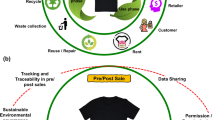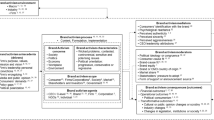Abstract
This article seeks to enrich the current discussion on place branding through a critical examination of the role of architecture and integrated design in branding a city. While accepting that there has been a significant contribution from the fields of product branding and corporate branding to the field of place branding, the article will argue that cities need a distinctive form of branding – one that is design-led and based on social innovation policy, combined with architectural theory and practice. In addition to this, the article will also present a new case study that will highlight in detail how an integrated design strategy is currently being applied in practice in Australia, and how this strategy can contribute to city branding.
Similar content being viewed by others
References
5000+. (2011) Integrated Design Strategy for Inner Adelaide. Adelaide, Australia: Department of the Premier and Cabinet, Government of South Australia.
American Treasures of the Library of Congress. (2010) Original plan of Washington DC, http://www.loc.gov/exhibits/treasures/tri001.html, accessed 10 December 2010.
Anholt, S. (2008) Editorial: Place branding: Is it marketing, or isn’t it? Place Branding and Public Diplomacy 4 (1): 1–6.
Anholt, S. (2010) Editorial: Definitions of place branding – Working towards a resolution. Place Branding and Public Diplomacy 6 (1): 1–10.
Ashworth, G. and Kavaratzis, M. (2009) Beyond the logo: Brand management for cities. Brand Management 16 (8): 520–531.
Berg, P.O. and Kreiner, K. (1990) Corporate architecture: Turning physical settings into symbolic resources. In: P. Gagliardi (ed.) Symbols and Artefacts: Views of the Corporate Landscape. New York: Aldine de Gruyter, pp. 41–67.
Bourrienne, L.A.F.de. (1832) The Life of Napoleon Bonaparte. Philadelphia, PA: Carey & Lea.
Brauer, G. (ed.) (2002) Architecture as Brand Communication. Basel, Switzerland: Birkhauser.
Cannadine, D. (1999) The context, performance and meaning of ritual: The British monarchy, c. 1820–1977. In: E. Hobsbawm and T. Ranger (eds.) The Invention of Tradition. Cambridge, MA: Cambridge University Press, pp. 101–164.
Chung, C.J., Inaba, J., Koolhaas, R. and Leong, S.T. (2001) Harvard Design School Guide to Shopping. London: Taschen.
Cornelissen, J.P. (2008) Corporate Communication: A Guide to Theory and Practice. Thousand Oaks, CA: Sage.
Diamond, J. (2003) Archaeology: Propaganda of the pyramids. Nature 424: 891–893.
Dovey, K. (1999) Framing Places: Mediating Power in Built Form. London: Routledge.
Economist Intelligence Unit. (2011) Liveability Ranking Report August 2011. The Economist, http://www.eiu.com/public/topical_report.aspx?campaignid=liveabilityAug2011, accessed 21 October 2011.
Fattah, H. (2007) Celebrity architects reveal a daring cultural Xanadu for the Arab world. The New York Times, 1 February, http://www.nytimes.com/2007/02/01/arts/design/01isla.html, accessed 9 December 2010.
Glendinning, M. (2004) The Last Icons: Architecture Beyond Modernism. Glasgow, Scotland: Graven Images.
Gobé, M. (2001) Emotional Branding. New York: Allworth Press.
Greenberg, M. (2000) Branding cities: A social history of the urban lifestyle magazine. Urban Affairs Review 36 (2): 228–263.
Griffiths, R. (1998) Making sameness: Place marketing and the new urban entrepreneurialism. In: N. Oatley (ed.) Cities, Economic Competition and Urban Policy. London: Paul Chapman Publishing, pp. 41–57.
Hankinson, G. (2010) Place branding research: A cross-disciplinary agenda and the views of practitioners. Place Branding and Public Diplomacy 6 (4): 300–315.
Hubbard, P. and Hall, T. (1998) The entrepreneurial city and the new urban politics. In: T. Hall and P. Hubbard (eds.) The Entrepreneurial City: Geographies of Politics, Regime and Representation. Chichester, UK: John Wiley & Sons, pp. 1–23.
Jana, R. (2006) Dubai's architectural wonders. Business Week, 2 March, http://www.businessweek.com/innovate/content/mar2006/id20060302_615308.htm, accessed 9 December 2010.
Jencks, C. (2005) The Iconic Building. London: Francis Lincoln.
Julier, G. (2000) The Culture of Design. London: Sage.
Kaika, M. (2010) Architecture and crisis: Re-inventing the icon, re-imag(in)ing London and re-branding the city. Transactions of the Institute of British Geographers 35: 453–474.
Kavaratzis, M. (2004) From city marketing to city branding: Towards a theoretical framework for developing city brands. Place Branding 1 (1): 58–73.
Kavaratzis, M. (2009) Cities and their brands: Lessons from corporate branding. Place Branding and Public Diplomacy 5 (1): 26–37.
Kavaratzis, M. and Ashworth, G. (2005) City branding: An effective assertion of identity or a transitory marketing trick? Tijdschrift voor Economische en Sociale Geografie 96 (5): 506–514.
Kelley, K.E. (2003) Architecture for sale(s). Harvard Design Magazine 17: 1–6.
Kirby, A.E. and Kent, A.M. (2010) Architecture as brand: Store design and brand identity. Journal of Product and Brand Management 19 (6): 432–439.
Klingmann, A. (2007) Brandscapes. Cambridge, MA: MIT Press.
Kotler, P., Asplund, C., Rein, I. and Heider, D. (1999) Marketing Places Europe: Attracting Investments, Industries, Residents and Visitors to European Cities, Communities, Regions and Nations. London: Pearson Education.
Lee, L. (2011) An Integrated Design Strategy for South Australia: Building the Future. Adelaide, Australia: Adelaide Thinkers in Residence, Department of the Premier and Cabinet, Government of South Australia.
Lewis, P. (2009) Dubai's six year building boom grinds to a halt as financial crisis takes hold. The Guardian, 13 February, http://www.guardian.co.uk/world/2009/feb/13/dubai-boom-halt, accessed 9 December 2010.
Mayes, R. (2008) A place in the sun: The politics of place, identity and branding. Place Branding and Public Diplomacy 4 (2): 124–135.
Mayo, J.M. (1996) The manifestation of politics in architectural practice. Journal of Architectural Education 50 (2): 76–88.
McIntyre, D. (2009) Dubai bailout may come from rich neighbor Abu Dhabi. Daily Finance, 28 November, http://www.dailyfinance.com/story/dubai-bailout-may-come-from-rich-neighbor-abu-dhabi/19256609/, accessed 16 December 2010.
McNeill, D. and Tewdwr-Jones, M. (2003) Architecture, banal nationalism and re-territorialization. International Journal of Urban and Regional Research 27 (3): 738–743.
Melewar, T.C. (2003) Determinants of the corporate identity construct: A review of the literature. Journal of Marketing Communication 9 (4): 195–220.
Mumford, L. (1961) The City in History: Its Origins, its Transformations, and its Prospects.. New York: Harvest.
National Register of Historic Places. (2001) Washington DC: The L’Enfant and McMillan plans. National Park Service US Department of the Interior, http://www.nps.gov/nr/travel/wash/lenfant.htm, accessed 10 December 2010.
Ouroussoff, N. (2007) A vision in the desert. The New York Times, 1 February, http://www.nytimes.com/2007/02/01/arts/design/04ouro.html, accessed 9 December 2010.
Ouroussoff, N. (2008) City on the Gulf: Koolhaas lays out a grand urban experiment in Dubai. The New York Times, 3 March, http://www.nytimes.com/2008/03/03/arts/design/03kool.html, accessed 9 December 2010.
Parkerson, B. and Saunders, J. (2005) City branding: Can goods and services branding models be used to brand cities? Place Branding 1 (3): 242–264.
Pinkney, D.H. (1955) Napoleon III's transformation of Paris: The origins and development of the idea. Journal of Modern History 27 (2): 125–134.
Sari, E. (2004) Architecture and branding. Dialogue: Architecture+Design+Culture 83: 22–99.
Sklair, L. (2010) Iconic architecture and the culture-ideology of consumerism. Theory, Culture and Society 27 (5): 135–159.
Szondi, G. (2007) The role and challenges of country branding in transition countries: The Central and Eastern European experience. Place Branding and Public Diplomacy 3 (1): 8–20.
Venturi, R. (1972) Learning from Las Vegas. Cambridge, MA: MIT Press.
Walker, A. (2010) Qatar's World Cup: Engineering marvel: PR nightmare? Fast Company, 12 June, http://www.fastcodesign.com/1662812/qatars-world-cup-engineering-marvel-pr-nightmare, accessed 9 December 2010.
Walsh, K. (2006) Branding the cities of god. Brand Strategy, (September): 27.
Whetten, D.A. (2006) Albert and Whetten revisited: Strengthening the concept of organisational identity. Journal of Management Inquiry 15 (3): 219–234.
Author information
Authors and Affiliations
Additional information
1holds a PhD in Design Research and Corporate Communication Strategies, with specialisation in Branding and Public Opinion Management. He has nearly 20 years of international, multidisciplinary design experience spanning from Europe and Asia, to the United States of America and Australia. He has also been working and collaborating with the United Nations Association of Australia, Toyota, Greenpeace, NASA Johnson Space Centre, UNESCO World Cultural Heritage, World Health Organisation (WHO), Department of the Premier and Cabinet of South Australia, Office of the Prime Minister of Macedonia, Dumfries and Galloway Council of Scotland, Ehrenberg-Bass Marketing Science Institute and others. He is also the Programme Coordinator for Design/Business Double Degrees at the Swinburne University of Technology, and Chairman of the agIdeas Research Conference: Design for Business – part of the agIdeas International Design Week (Australia).
Rights and permissions
About this article
Cite this article
Muratovski, G. The role of architecture and integrated design in city branding. Place Brand Public Dipl 8, 195–207 (2012). https://doi.org/10.1057/pb.2012.12
Received:
Revised:
Published:
Issue Date:
DOI: https://doi.org/10.1057/pb.2012.12




